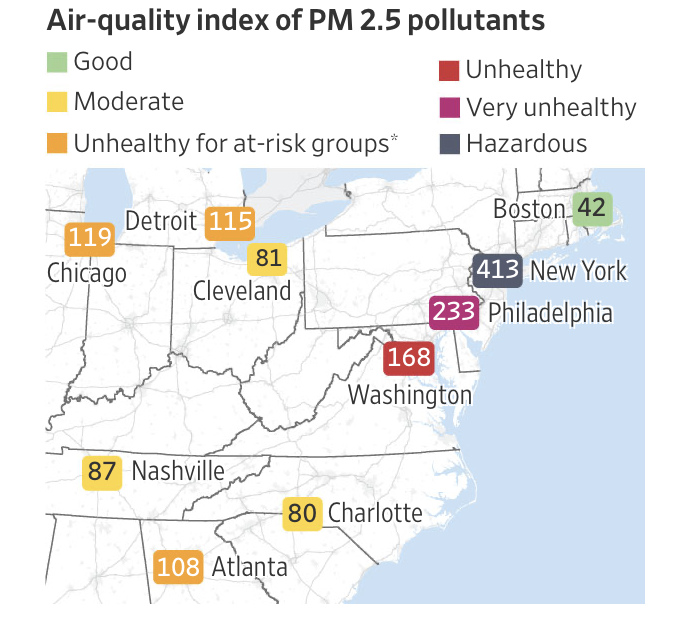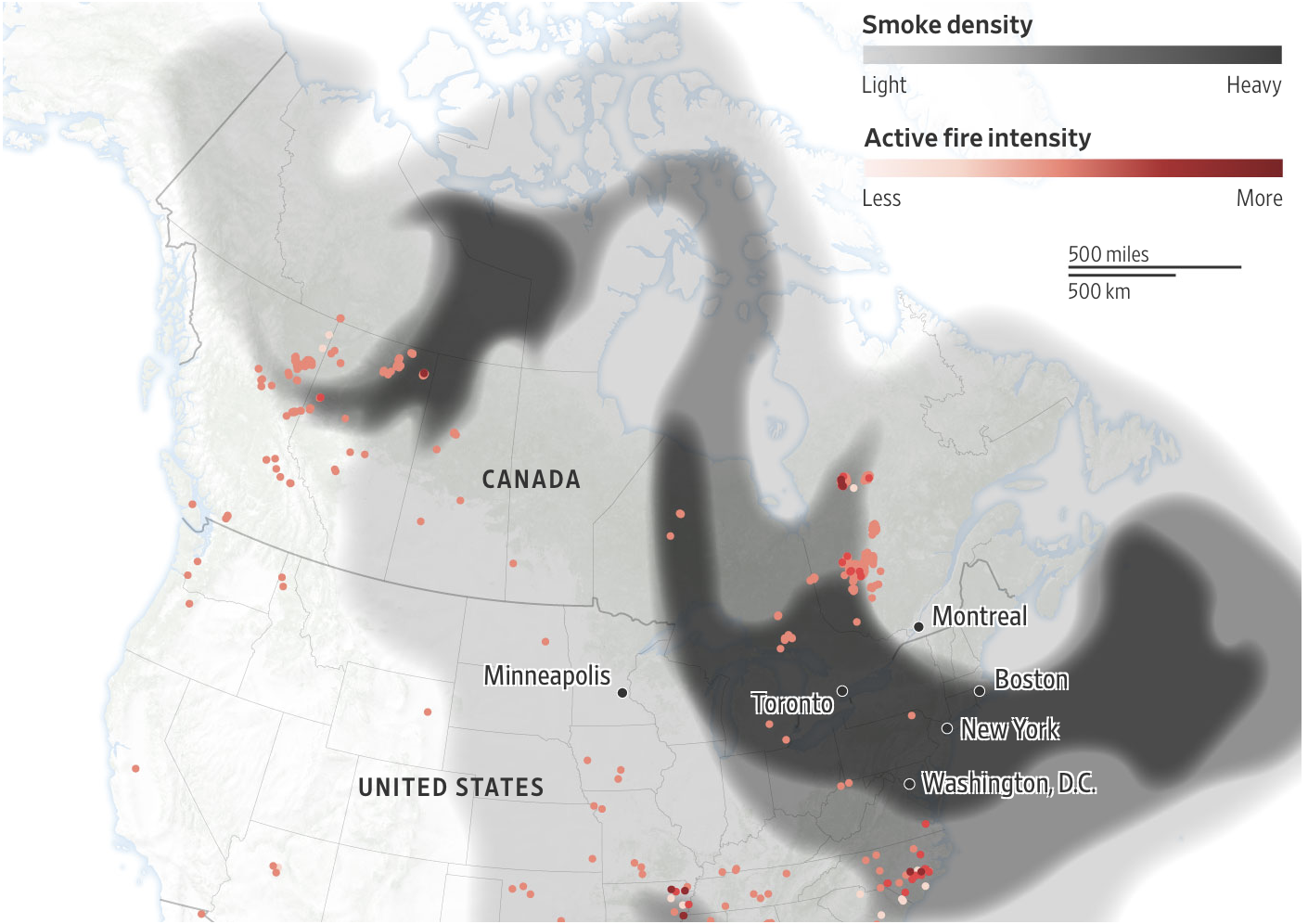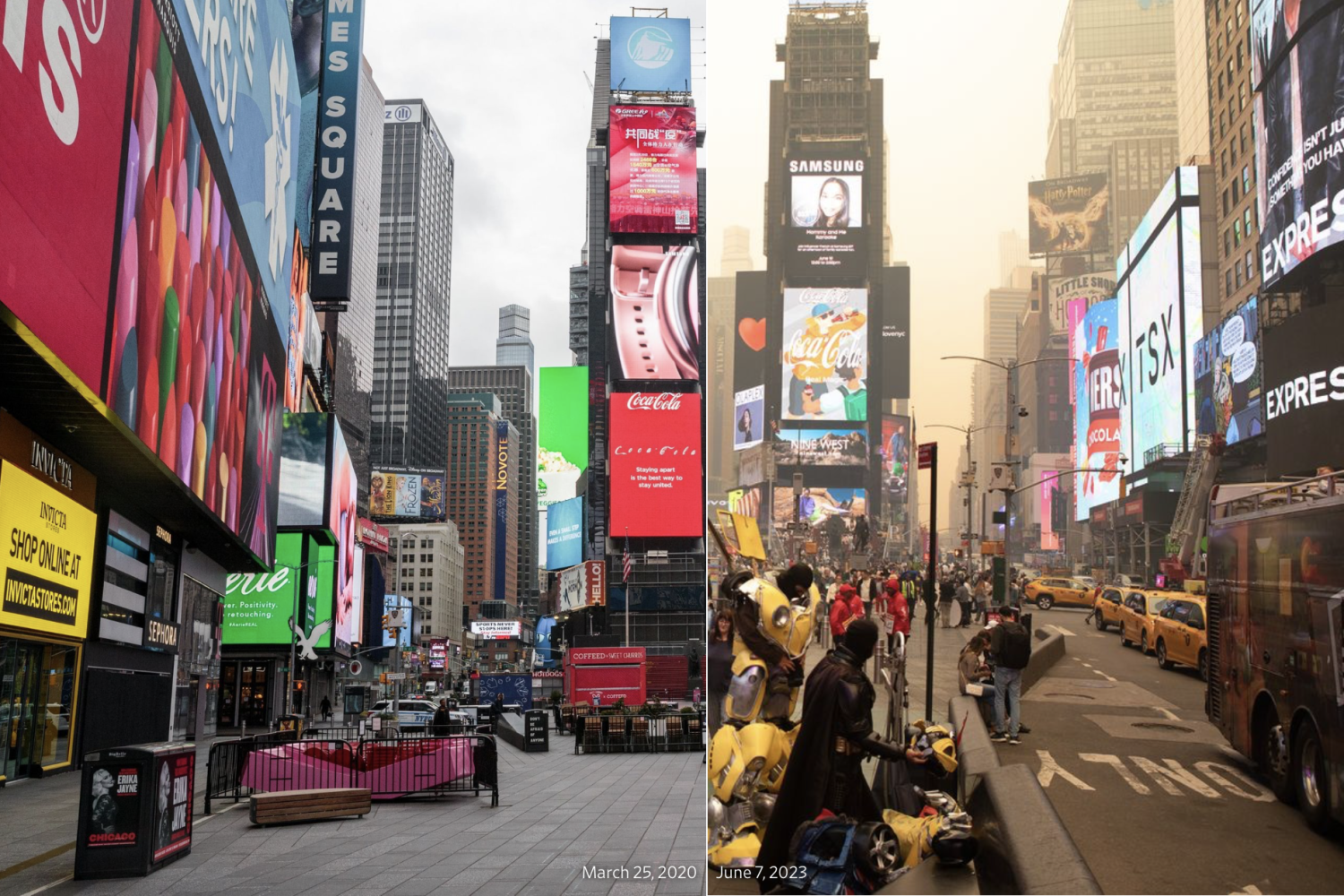This article is more than
2 year oldDrift from Canada prompts air-quality warnings for millions
NEW YORK—Smoke from hundreds of Canadian wildfires cast a persistent haze Wednesday over populous areas of the eastern U.S., and could last for days, as polluted air sent people with asthma to their doctors, disrupted air travel, postponed professional sports games and altered school schedules.
The smoky skies—with an eerie orange tint in New York City—rattled parts of the country unaccustomed to dealing with the lingering effects of widespread wildfires. Officials reported a flood of 911 calls in Pennsylvania and an uptick in emergency room visits in some parts of New York.
“As long as these fires remain active, large and uncontained, there’s going to be continued smoke lofted into the atmosphere,” said Zack Taylor, a meteorologist with the National Weather Service in College Park, Md.
Taylor said there is some chance of rain Thursday and Friday in the Northeast and New England that could help reduce air pollution. Forecasts suggest that the highest concentrations might move westward into places such as West Virginia.
Millions of Americans inhaled unhealthy air for the second straight day as more than 400 wildfires burned across Canada. Photo: Ed Jones/AFP/Getty Images
Lee Hendricks, a meteorologist for the National Weather Service in Pittsburgh, said a high pressure system in the West was helping to push smoke south into the U.S. Until the current weather pattern shifts, he said, “nothing is going to significantly improve.”
More than 40 million people live in areas that had unhealthy air quality, or worse, according to AirNow, a government tracking site. The air-quality reading for the New York City area at one point surpassed 400—well into the “hazardous” range that calls for all people to stay inside and reduce physical activity, AirNow said. An air-quality level above 300 is considered hazardous.

Source: AirNow
Andrew Mollica/THE WALL STREET JOURNAL
New York City officials said they were bracing for a multiple-day event, with landmarks such as the Empire State Building and Statue of Liberty veiled in smoke.
Mayor Eric Adams said the air quality in the city has been the worst since the 1960s. He added the city’s beaches would be closed Thursday, schools could be closed Friday, the Staten Island Ferry service has been curtailed and that New Yorkers should “limit outdoor activity to the greatest extent possible,” including private employees who could work from home.
Elsewhere, the areas around Newark, N.J., and Allentown, Pa., also tipped into the hazardous range, AirNow said.
The Federal Aviation Administration issued and then lifted a ground stop at LaGuardia Airport in New York City on Wednesday afternoon, halting departures briefly in the afternoon because of low visibility. Newark Liberty International and John F. Kennedy airports said the smoke was causing low visibility, delaying arrivals and departures.
The air quality as of midday Wednesday was also unhealthy in parts of Indiana, Maryland, Massachusetts, Michigan, New Jersey, Ohio and Virginia, among other states, according to AirNow. More than 100 million people in the U.S. were affected by air quality alerts on Wednesday, mostly because of the wildfires, the Environmental Protection Agency estimated.
Smoke from Canada Shrouds U.S.
More than 400 fires are currently burning across Canada. Winds moving north to south are transporting smoke from some fires to parts of the U.S., causing dips in air quality across more than a dozen states. Meteorologists said this weather pattern is expected to continue over the next several days.
Satellite-observed smoke plume extent on June 7

Source: National Oceanic and Atmospheric Administration
Emma Brown/THE WALL STREET JOURNAL
The smoke has moved south from Canada, where more than 400 active wildfires were burning across the country. Some of the worst fires were clustered in the eastern province of Quebec, which borders the U.S. Northeast, and to a lesser extent in Ontario.
Canadian officials have warned that the country could be on track for its most destructive wildfire season ever, meaning Americans could experience a smoky summer. Wildfires such as those ravaging Canada are becoming bigger and more frequent as forests around the world increasingly dry out amid the warming climate.
The U.S. has deployed over 600 firefighters and personnel, plus equipment, to help in Canada, White House press secretary Karine Jean-Pierre said Wednesday.
“For the foreseeable future, we don’t see how this smoke can go anywhere,” said Jean-Philippe Bégin, a meteorologist with Environment and Climate Change Canada, which is Canada’s weather forecasting and environmental agency. “I don’t see any improvement for 48 to 72 hours.”
Forecasters said people should limit their time outside because inhaling polluted air can cause headaches, irritated eyes, fatigue and difficulty breathing. Seniors, children and immunocompromised people should be especially careful. Health officials recommended people outside wear masks.
Dr. Daniel Croft, a pulmonologist at the University of Rochester Medical Center, said he was seeing patients in the asthma clinic Wednesday dealing with issues like coughing, wheezing and shortness of breath.

The emergency department at NewYork-Presbyterian/Columbia University Irving Medical Center has experienced an uptick in children visiting the department for asthma attacks, said Dr. Stephanie Lovinsky-Desir, chief of the hospital’s pediatric pulmonary division.
“There’s a strong link between air-pollution exposure, poor air quality and asthma attacks in children,” she said. “It’s super important that we protect our children’s lungs because that could have a lasting effect on them well into adulthood.”
Some schools, including in Washington, D.C., remained open with outdoor activities canceled. Some residents took up wearing masks outdoors. The Prospect Park Track Club scrapped a planned 5k race for Wednesday evening in Brooklyn, N.Y., in light of the smoke forecast.
The emergency department at NewYork-Presbyterian/Columbia University Irving Medical Center has experienced an uptick in children visiting the department for asthma attacks, said Dr. Stephanie Lovinsky-Desir, chief of the hospital’s pediatric pulmonary division.
“There’s a strong link between air-pollution exposure, poor air quality and asthma attacks in children,” she said. “It’s super important that we protect our children’s lungs because that could have a lasting effect on them well into adulthood.”
Some schools, including in Washington, D.C., remained open with outdoor activities canceled. Some residents took up wearing masks outdoors. The Prospect Park Track Club scrapped a planned 5k race for Wednesday evening in Brooklyn, N.Y., in light of the smoke forecast.
Keywords
Israel approves plan to 'conquer' Gaza if no hostage deal reached
Rihanna Announces Third Pregnancy Ahead of Met Gala Appearance
After Trump vows tariffs on foreign movies, the Canadian film industry says he's lost the plot
Trump criticised after posting AI image of himself as Pope
Why do popes choose different names and what could the name of the new pope be?
Harvard President on Trump Attacks: ‘The Fight Came to Me’
Lady Gaga concert ‘targeted for bomb attack’
Houthi missile hits near Israel's main airport
Trump says he would extend TikTok deadline if no deal reached by June 19




